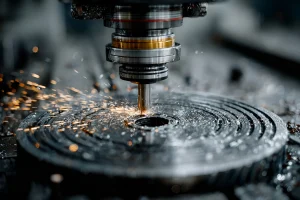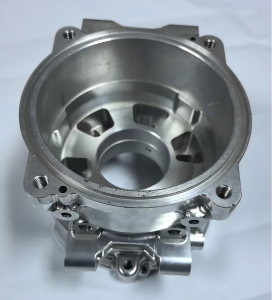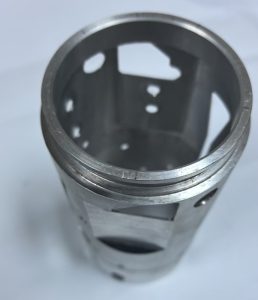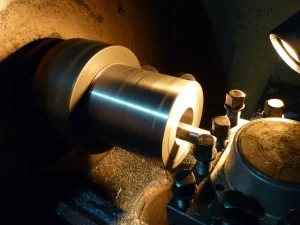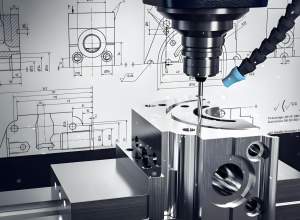I. Introduction
In the realm of modern manufacturing, aerospace parts processing stands as a pinnacle of precision, complexity, and technological prowess. The aerospace industry, with its ceaseless pursuit of safer, faster, and more efficient flight, demands components that meet the most exacting standards. From the turbine blades that power jet engines to the intricate avionics housings that house critical electronics, each part plays a vital role in the overall performance and safety of aerospace vehicles. This is where advanced processing technologies and the expertise of companies like Rapidefficient come into play, revolutionizing the way aerospace parts are manufactured and setting new benchmarks in the CNC machining market.
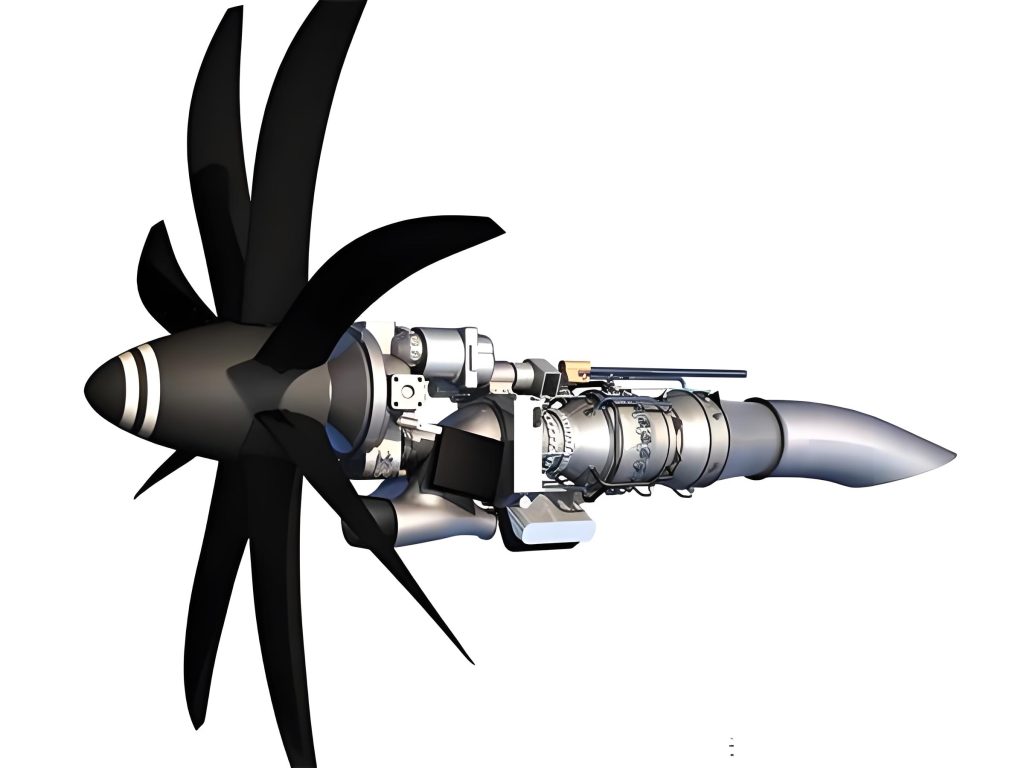
II. Understanding Aerospace Parts Processing
Aerospace parts processing refers to the intricate and precise manufacturing procedures involved in transforming raw materials into components that meet the stringent requirements of the aerospace industry. This encompasses a vast array of parts, ranging from the highly complex turbine blades that drive jet engines, to the structural frameworks that form the backbone of aircraft fuselages, and the delicate avionics enclosures that safeguard crucial electronic systems. Each of these parts demands an exceptional level of precision, reliability, and performance, given the extreme operating conditions and safety-critical nature of aerospace applications.
For instance, aircraft engine blades must endure temperatures exceeding 1,500 degrees Celsius, rotational speeds of tens of thousands of revolutions per minute, and immense mechanical stresses. This necessitates materials like nickel-based superalloys, which offer excellent heat resistance and strength. However, these materials are notoriously difficult to machine, requiring specialized cutting tools and techniques to achieve the required tolerances. Similarly, the fuselage framework demands high-strength aluminum alloys or advanced composites that can balance strength, weight reduction, and durability, while maintaining precise dimensional accuracy to ensure seamless assembly and aerodynamic integrity.
III. Key Processing Technologies
A. CNC Machining
CNC (Computer Numerical Control) machining lies at the heart of aerospace parts processing. It operates on the principle of using computer-aided design (CAD) and computer-aided manufacturing (CAM) software to translate complex part designs into precise machine instructions. The CNC machine then executes these instructions with remarkable accuracy, controlling the movement of cutting tools in multiple axes to shape the raw material into the desired component. This level of precision is crucial in aerospace, where tolerances can be as tight as a few microns. For instance, in the production of turbine blades, CNC machining enables the creation of intricate airfoil profiles and cooling channels that enhance engine efficiency and performance. Rapidefficient’s CNC machining capabilities, equipped with advanced tooling and high-speed spindles, significantly reduce production time while maintaining the strictest quality standards. Their machines can handle a wide range of materials, from aluminum alloys to superalloys, ensuring versatility in meeting diverse aerospace part requirements.
B. 3D Printing Technology
3D printing, or additive manufacturing, has emerged as a game-changer in aerospace parts production. It builds parts layer by layer from powdered or filament materials, based on digital 3D models. This technology offers several advantages over traditional subtractive machining methods. Firstly, it enables rapid prototyping, allowing engineers to quickly iterate and test designs before committing to full-scale production. In the development of new aircraft components, this can shave weeks or even months off the design cycle. Secondly, 3D printing excels in fabricating complex geometries that are difficult or impossible to achieve with conventional machining. For example, lattice structures and internal cooling channels can be integrated into parts to enhance strength and thermal management. Aerospace companies have utilized 3D printing to produce lightweight brackets, fuel nozzles, and even entire engine components, reducing weight and improving fuel efficiency. It also minimizes material waste, as only the exact amount of material needed for the part is used, making it an environmentally friendly option.
C. High-Speed Machining
High-speed machining is another critical technology in aerospace parts processing. It involves operating cutting tools at extremely high rotational speeds and feed rates, typically several times faster than traditional machining. The key benefits include enhanced productivity, as parts can be machined in significantly less time. Additionally, high-speed machining can improve surface finish quality, reducing the need for secondary finishing operations. In aerospace applications, where many components require smooth surfaces to minimize aerodynamic drag or ensure proper sealing, this is of utmost importance. For materials like aluminum alloys, which are commonly used in aircraft structures due to their favorable strength-to-weight ratio, high-speed machining allows for efficient material removal while maintaining dimensional accuracy. Specialized cutting tools and machine tool designs are employed to withstand the high forces and temperatures generated during high-speed cutting, ensuring reliable and precise manufacturing.
IV. The Significance of Rapidefficient in CNC Machining Market
A. Time and Cost Efficiency
In the highly competitive aerospace industry, time and cost efficiency are of the essence. Rapidefficient’s CNC machining capabilities offer significant advantages in this regard. Compared to traditional machining methods, their advanced systems reduce production time by up to 30%. For example, in the manufacturing of a typical aerospace bracket, traditional machining might take several hours, involving multiple setups and tool changes. Rapidefficient’s optimized CNC processes, with high-speed spindles and rapid tool changeovers, can complete the same task in less than half the time. This is achieved through intelligent tool path planning, which minimizes unnecessary movements and maximizes cutting time. Additionally, by reducing human intervention and automating repetitive tasks, the company cuts labor costs by approximately 20%. The use of advanced software simulations prior to actual machining also helps identify potential errors early on, preventing costly rework and material waste. Overall, these efficiencies translate into shorter lead times for aerospace projects, enabling companies to respond more quickly to market demands and gain a competitive edge.
B. Quality Enhancement
Quality is non-negotiable in aerospace parts manufacturing, and Rapidefficient excels in delivering superior quality components. Their CNC machines are equipped with state-of-the-art error compensation systems that can correct for minute deviations in real-time, ensuring dimensional accuracy within a tolerance of a few microns. In the production of turbine blades, for instance, where even the slightest imperfection can lead to catastrophic consequences, Rapidefficient’s precision machining guarantees the exact aerodynamic profiles required for optimal engine performance. The surface finish achieved by their high-speed machining and advanced polishing techniques is also exceptional, reducing drag and enhancing the overall efficiency of aerospace vehicles. Moreover, the company adheres to strict quality control protocols, with multiple inspection points throughout the manufacturing process. This includes in-process metrology using advanced 3D scanning and coordinate measuring machines (CMMs), ensuring that each part meets or exceeds the stringent aerospace industry standards. By consistently providing high-quality parts, Rapidefficient not only enhances the safety and reliability of aerospace products but also helps manufacturers avoid costly recalls and repairs in the long run.
V. Challenges and Solutions in Aerospace Parts Processing
A. Material Difficulties
The aerospace industry frequently employs exotic materials renowned for their exceptional strength, heat resistance, and lightweight properties. Titanium alloys, for instance, are widely favored due to their high strength-to-weight ratio and corrosion resistance, making them ideal for critical components like landing gear and engine parts. However, machining titanium alloys presents significant hurdles. Their low thermal conductivity causes heat to concentrate at the cutting edge, leading to rapid tool wear. The material’s high strength and chemical reactivity also make it prone to work hardening and chip adhesion. To overcome these challenges, advanced cutting tools with specialized coatings, such as titanium nitride or diamond-like carbon, are employed. These coatings reduce friction, enhance tool life, and improve chip evacuation. Additionally, high-pressure coolant systems are utilized to dissipate heat effectively and flush away chips, ensuring smooth machining operations. For example, in the production of titanium alloy turbine blades, precise control of cutting parameters and the use of cryogenic cooling techniques have enabled manufacturers to achieve the required surface finish and dimensional accuracy.
B. Complex Design Requirements
Aerospace components often feature intricate geometries and tight tolerances, demanding highly precise manufacturing processes. Engine parts, such as turbine discs and compressor blades, possess complex internal cooling channels and aerodynamic profiles that are crucial for optimal performance. Fabricating these parts requires advanced machining techniques like multi-axis milling and electro-discharge machining (EDM). Multi-axis machining allows for simultaneous movement of the cutting tool along multiple axes, enabling the creation of complex shapes in a single setup. This not only reduces production time but also enhances accuracy by minimizing errors associated with part repositioning. EDM, on the other hand, is invaluable for machining hard materials and creating fine details, such as micro-holes and narrow slots, that are impossible to achieve with conventional cutting methods. In the manufacturing of aerospace fuel injectors, EDM is used to produce microscopic orifices with extremely tight tolerances, ensuring precise fuel flow and combustion efficiency. Moreover, the integration of computer-aided design (CAD) and computer-aided manufacturing (CAM) software enables engineers to simulate and optimize machining processes before actual production, reducing the risk of costly errors and rework.
VI. Case Studies
A. Project A: Engine Turbine Blade Production
In a recent aerospace project, the objective was to manufacture high-performance turbine blades for a next-generation jet engine. The blades were required to have intricate cooling channels, precise aerodynamic profiles, and withstand extreme temperatures and rotational forces. The material chosen was a nickel-based superalloy, known for its excellent heat resistance but notorious for its machining difficulties.
Rapidefficient took on the challenge and implemented a combination of advanced CNC machining and 3D printing technologies. Firstly, the initial blade prototypes were rapidly fabricated using 3D printing to validate the design and functionality. This allowed engineers to make quick design iterations, reducing the design cycle time by 40%. Once the design was finalized, the actual production was carried out using high-precision CNC machining.
The company utilized state-of-the-art multi-axis CNC machines equipped with specialized tooling and high-pressure coolant systems. The multi-axis capabilities enabled the simultaneous machining of complex blade geometries, ensuring accurate and consistent production. The high-pressure coolant effectively dissipated heat, preventing tool overheating and ensuring chip evacuation, which was crucial for maintaining surface finish and dimensional accuracy.
As a result, Rapidefficient successfully manufactured the turbine blades within the tight project deadline. The blades exhibited exceptional quality, with dimensional tolerances held within a few microns, and surface finishes that met or exceeded the industry standards. This not only contributed to the overall performance and efficiency of the jet engine but also enhanced the reliability and safety of the aerospace vehicle.
B. Project B: Aircraft Fuselage Structural Component Manufacturing
Another significant project involved the production of large aluminum alloy structural components for an aircraft fuselage. The components required precise machining of numerous holes, slots, and complex contours to ensure seamless assembly and structural integrity.
Rapidefficient employed its high-speed machining technology, combined with advanced CAD/CAM software simulations. The high-speed machining capabilities allowed for rapid material removal, reducing the production time by approximately 35% compared to traditional machining methods. The CAD/CAM simulations enabled the optimization of tool paths and machining strategies before actual production, minimizing errors and rework.
During the machining process, the company faced challenges related to maintaining dimensional accuracy due to the large size and complex shape of the components. To overcome this, they implemented in-process metrology using advanced 3D scanning and coordinate measuring machines (CMMs). This real-time measurement and feedback system ensured that any deviations were detected and corrected immediately, guaranteeing that the final components met the strict aerospace tolerances.
The successful completion of this project not only provided the aircraft manufacturer with high-quality fuselage components but also demonstrated Rapidefficient’s ability to handle complex and large-scale aerospace part manufacturing, further solidifying its reputation in the industry.
VII. Future Trends
Looking ahead, the aerospace parts processing industry is poised for remarkable advancements. One of the most prominent trends is the increasing integration of artificial intelligence and machine learning into manufacturing processes. Smart machining systems will be capable of self-optimization, adapting to changing workpiece requirements and tool conditions in real-time. This will further enhance precision and productivity, while minimizing human errors. For instance, AI algorithms could predict tool wear and automatically adjust cutting parameters to maintain optimal performance, reducing downtime and scrap rates.
Another significant development is the continued exploration and application of new materials. Advanced composites, such as carbon fiber-reinforced polymers with even higher strength-to-weight ratios, will see wider adoption. These materials not only contribute to lighter aircraft structures but also offer improved durability and resistance to extreme conditions. Additionally, the rise of nanomaterials holds the potential to revolutionize aerospace components, with enhanced thermal and electrical properties that could lead to more efficient engines and electronics.
Rapidefficient is well-positioned to embrace these future trends. Their continuous investment in research and development ensures that they stay at the forefront of technological innovation. By collaborating with leading research institutions and industry partners, they are able to anticipate and integrate emerging technologies into their manufacturing processes. Whether it’s adopting new AI-driven machining strategies or working with novel materials, Rapidefficient is committed to delivering the highest quality aerospace parts and driving the industry forward.
VIII. Conclusion
In conclusion, aerospace parts processing is a remarkable blend of art and science, demanding the highest levels of precision, innovation, and expertise. The technologies discussed, from CNC machining and 3D printing to high-speed machining, are the driving forces behind the industry’s ability to produce components that meet the sky-high expectations of aerospace applications. Rapidefficient emerges as a key player in this domain, with its commitment to time and cost efficiency, as well as unwavering dedication to quality. Their contributions not only enhance the competitiveness of aerospace manufacturers but also contribute to the overall safety and advancement of the aerospace industry. As we look ahead, with emerging trends on the horizon, companies like Rapidefficient will continue to play a pivotal role in shaping the future of aerospace parts processing. Whether you’re involved in aerospace design, manufacturing, or simply an enthusiast, understanding these processes and the value of advanced machining services is essential. Consider partnering with Rapidefficient for your next aerospace project and experience the difference in precision-engineered components that take flight.

